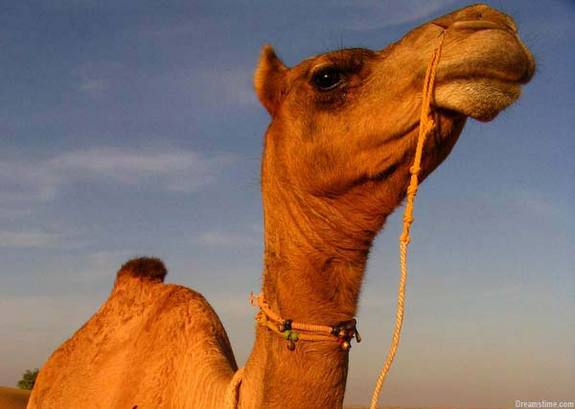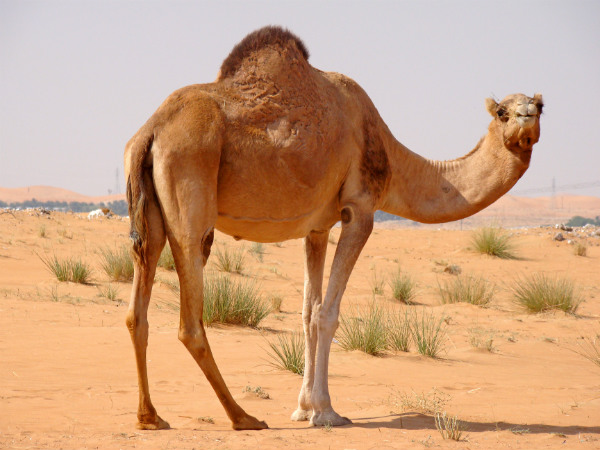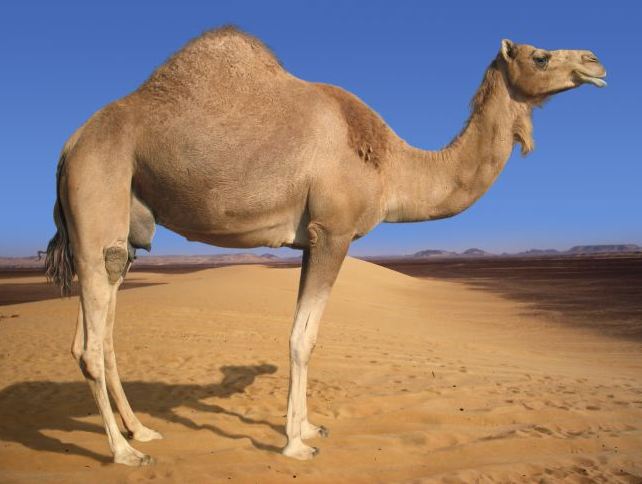
The ancestors of camels evolved in North America fifty million years ago. The oldest relatives were only twelve inches tall and lacked humps. About three million years ago, one branch migrated across a land bridge to Asia, becoming today's camels. Later, others moved to South America to become the lamoids, which include the vicuГ±a, guanaco, llama, and alpaca. The North American camelids became extinct after the last ice age, perhaps due to climate change but more likely from overhunting by humans who were occupying the continent at that time. Dromedary camels were domesticated four thousand years ago in Arabia, while the Bactrians were independently domesticated five hundred years later in Central Asia. While primarily used for transport, they are also valued for milk, meat, hair, leather, and dung, which is dried and used for fuel. Although some wild Bactrian camels may still exist in remote regions such as China's western Xinjiang Province, most camels are domesticated or feral. Worldwide, camels are estimated at twenty million, 75 percent in North Africa (from Morocco to Somalia) and 25 percent in Asia (from Arabia to Mongolia), with twenty thousand in Europe and Australia.
Physical Characteristics of Camels
Camels, among the largest terrestrial animals at more than seven feet tall and ten feet long, are well adapted to arid regions of the world. Their long legs keep their bodies away from the hot surface of the ground. In addition, they have a thin profile when viewed from the front; this permits them to minimize absorbing solar radiation by facing the sun, which they do in the hottest periods of the year. Furthermore, they allow their body temperatures to rise up to 108 degrees Fahrenheit. They conserve water by having very efficient evaporative cooling and by producing very concentrated urine and dry, pelleted feces. They can also endure a substantial loss in body water,upto 40 percent of their body weight, with little harm or loss of appetite; they preserve the water in the blood at the expense of that in their tissues and alimentary tract. Furthermore, when rehydrating, they can consume up to fifty gallons of water without damaging their tissues or red blood cells; the latter can expand 2.4-fold without bursting. Contrary to popular myth, their humps do not provide water storage, consisting instead mostly of fat that can be used as a metabolic fuel. When camels are starved, theirhumpswill regress or become limp. Camels are herbivores and eat a variety of plant material, grass, brush, and trees, subsisting well on browse with low nutritional value. As a result, their food preferences are complementary to those of other domesticated and wild animals. They can obtain much of their water needs from plants.With sufficient food and at moderate temperatures, they have been known to go months without drinking. They ruminate, permitting rapid ingestion of food and subsequent regurgitation and rechewing. Unlike cattle and sheep, they have three rather than four stomach compartments, although the first one, the rumen, is similarly used for microbial fermentation of plant material that would otherwise be indigestible. Camels can carry loads of three hundred pounds and cover up to one hundred miles a day (although twenty-five to fifty is typical). They are loaded or mounted when they are in a kneeling position. They have a pacing gait, where both feet on each side move together, and their broad, padded feet keep them from sinking in sand. To deal with sandstorms, they have a third eyelid that comes up from below the eye, long eyelashes, and nostrils that they can close. Camels have very good eyesight; their eyes are protected from bright sunshine by a bony protrusion. They also have a keen sense of smell; reputedly, they can smell water a mile away. Like their South American cousins, camels mate in a crouched position. Their pregnancies last thirteen months, resulting generally in single offspring. Females have relatively small mammary glands between their rear legs. They become sexually mature at three to four years, continue to grow until they are fifteen or older, and can live to be forty years old, although most are killed for meat before then.
Comparison of Dromedary and Bactrian Camels
The most obvious difference between the two types of camels is that dromedaries have one hump and Bactrians have two. During embryonic development, both have two humps, but one regresses before birth in dromedaries, although the vestige of that second hump is sometimes visible in front of themore prominent one. Bactrians are also shorter and hairier; these adaptations permit them to survive at the higher and colder elevations of the deserts of Central Asia. They survive at temperatures below freezing in winter and in the summer above 120 degrees Fahrenheit. They shed their hair in the spring and regrow it in the fall. Bactrians also have tougher foot-pads to deal with a more rocky terrain. Bactrians are slower animals; some dromedaries are bred as racing animals. These two types of camels are fully interfertile and, accordingly, belong to the same species. Dromedaries are much more numerous than Bactrian camels.
Future of Camels
Camels are closely linked to the largely nomadic existence of their owners, whose lifestyle is succumbing to the demands of modern nation-states for more sedentary populations and respect for national borders, as well as the increasingly pervasive use of motor vehicles. These factors put the survival of camels at risk. However, they remain the best-adapted large animal in the most arid desert regions of the world and are not currently endangered as domestic or feral animals, although the remaining wild camels in Central Asia are under threat due to the fact that their natural habitat is China's nuclear test range. Camels could have increasing value for adventure vacations in the remote deserts of the world.
Camel Facts
Classification:
Kingdom: Animalia
Subkingdom: Bilateria
Phylum: Chordata
Subphylum: Vertebrata
Class: Mammalia
Order: Artiodactyla
Suborder: Tylopoda
Family: Camelidae
Genus and species: Camelus dromedarius (onehumped
camel), C. bactrianus (two-humped
camel)
Geographical location: Africa and Asia
Habitat: Deserts
Gestational period: Thirteen months
Life span: Up to forty years
Special anatomy: One hump or two humps on
the back; several adaptations that permit them
to conserve water
Other popular Animals
Photo Gallery of - Camel








 Animalia Life
Animalia Life